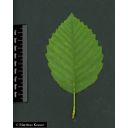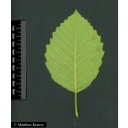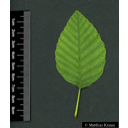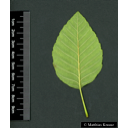Useful information about the taxon (species, subspecies, variety...)
Alnus rubra Bong. 1833
Betulaceae
(APG IV)red alder, Oregon alder, western alder
Akzessionnummer: EG-I-011-18094
Pflanzjahr: 2012
Patenschaftstext: Prof. Hans Schenkel zum 70. Geburtstag
Taxon concept: The Plant List (2014), version 1.1
Distribution: Alaska, West Canada; USA: northwest, Idaho, California
Size: 24 - 30 (m)
Alnus rubra Bong. - Accepted: Alnus rubra Bong. bei The Plant List (2014), version 1.1; Familie: Betulaceae (APG III)
- Flowers
- monoecious; male (staminate) flowers in drooping catkins, female (pistillate) flowers in erect catkins
- Flower ecology
- wind-pollinated (anemophilous)
- Life form
- tree
- Foliage persistence
- deciduous
- Fruits
- flattened, winged nut fruit (samara)
- Fruit ecology
- wind-dispersed (anemochorous)
- Soil conditions
- on well-drained, gravelly and sandy soils to poorly drained clay or organic soils, also on colluvial soils of volcanic origin
- Root type
- shallow root system
- Succession type
- pioneer species
- Natural occurrence (habitat)
- along streams, moist bottomlands, moist lower slopes, riparian deciduous forests, coniferous forests, Douglas-fir forests
- Vegetation typ and synecology (plant community)
- temperate mixed deciduous forests to boreal coniferous forests
- Constraints according radiation (light)
- shade-intolerant
- Comments
- begin of seed production at about 10 years
- Life span
- relatively short-lived (up to 100 years)
- Usage
- wood is used for furniture making and cabinetry; also used for paneling, pallets, veneers, boxes, brush handles, shoe soles, and as firewood; formerly used for medicinal purposes (probably due its contained salicin)
- Bark
- thin, smooth, grey-whitish mottled, often moss-covered bark
- Altidudinal lower limit (sea level in m)
- 0
- Altitudinal higher limit (sea level in m)
- 1,097
Erhardt, W., Götz, E., Bödeker, N. & Seybold, S. (2008): Der große Zander. Enzyklopädie der Pflanzennamen. Band 2. Arten und Sorten. Eugen Ulmer KG, Stuttgart (Hohenheim), 18. Aufl., 2103 S.; Kandemir, G. & Kaya, Z. (2009): EUFORGEN. Technical guidelines for genetic conservation and use of Oriental beech (Fagus orientalis). Rome. Available at: http://www.euforgen.org.; The IUCN Red List of Threatened Species. www.iucnredlist.org;
Diese Webseite verwendet Google Maps, um Karten und Standorte von Pflanzen in den Hohenheimer Gärten anzuzeigen. Dadurch werden unter Umständen Daten an Google weitergeleitet, was mit einer Verarbeitung Ihrer personenbezogenen Daten verbunden sein kann. Die Datenschutzerklärung von Google finden Sie hier: Datenschutzerklärung von Google




